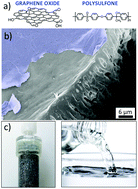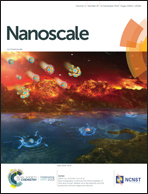Graphene oxide–polysulfone filters for tap water purification, obtained by fast microwave oven treatment†
Abstract
The availability of clean, pure water is a major challenge for the future of our society. 2-Dimensional nanosheets of GO seem promising as nanoporous adsorbent or filters for water purification; however, their processing in macroscopic filters is challenging, and their cost vs. standard polymer filters is too high. Here, we describe a novel approach to combine graphene oxide (GO) sheets with commercial polysulfone (PSU) membranes for improved removal of organic contaminants from water. The adsorption physics of contaminants on the PSU-GO composite follows Langmuir and Brunauer–Emmett–Teller (BET) models, with partial swelling and intercalation of molecules in between the GO layers. Such a mechanism, well-known in layered clays, has not been reported previously for graphene or GO. Our approach requires minimal amounts of GO, deposited directly on the surface of the polymer, followed by stabilization using microwaves or heat. The purification efficiency of the PSU-GO composites is significantly improved vs. benchmark commercial PSU, as demonstrated by the removal of two model contaminants, rhodamine B and ofloxacin. The excellent stability of the composite is confirmed by extensive (100 hours) filtration tests in commercial water cartridges.

- This article is part of the themed collection: Nanocarbons


 Please wait while we load your content...
Please wait while we load your content...